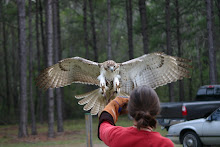I want to take a break from my training history to give an update from Hurricane Fay. It was pretty exciting for us! We got the Florida version of a “snow day”, both Hazen and I were given administrative leave and told to stay home and brace for the storm. It would have been really fun if I hadn’t come down with a nasty cold that I’m still getting over. Oh well, it was nice to sit at home, listen to the wind and rain, and watch the Olympics.
We had no major damage, but we did have a lot of limbs come down and a few dead trees in the lot behind our house came down as well. But over-all, this was a tame one and a nice wake-up call to us Floridians who have gotten complacent over the last year. It’s easy to forget about these devastating storms until you have one barreling down. Fay hit the whole state. It came over the keys, crossed over the state south of us, and then turned right around and came back over us. We got the first of it Thursday night with the wind picking up pretty good and torrential rains, but no lightning or thunder. Earlier that week Hazen and I caught Musket in the dark so we could get jesses on her in case I got nervous about the storm and wanted to bring her it. I was doing fine until we started getting 50mph wind gusts, then I got worried about her in the rain and wind in the dark. When we finally got a lull in the rain, Hazen and I ran out and brought her in for the night. As you can see in the picture, she was pretty bedraggled. She simply refuses to get under shelter and will sit out in the rain all day long, silly bird. She spent the night in her giant hood in a warm room.
We had no major damage, but we did have a lot of limbs come down and a few dead trees in the lot behind our house came down as well. But over-all, this was a tame one and a nice wake-up call to us Floridians who have gotten complacent over the last year. It’s easy to forget about these devastating storms until you have one barreling down. Fay hit the whole state. It came over the keys, crossed over the state south of us, and then turned right around and came back over us. We got the first of it Thursday night with the wind picking up pretty good and torrential rains, but no lightning or thunder. Earlier that week Hazen and I caught Musket in the dark so we could get jesses on her in case I got nervous about the storm and wanted to bring her it. I was doing fine until we started getting 50mph wind gusts, then I got worried about her in the rain and wind in the dark. When we finally got a lull in the rain, Hazen and I ran out and brought her in for the night. As you can see in the picture, she was pretty bedraggled. She simply refuses to get under shelter and will sit out in the rain all day long, silly bird. She spent the night in her giant hood in a warm room.

The next morning, I put Musket back out in her mew after things had calmed down. I guess I should have known better because we were in the eye of the Hurricane which spanned about 65 miles so it took many hours to move over us. Well, things get pretty calm in the eye, clear skies, little wind, and you start to think it’s over. The wind picked up again towards the late afternoon moving the other direction just as strong as before, so I went and brought Musket in again to spend another night safe in her box. I took the opportunity to weigh her and she was just over 50 ounces! Sigh… I have almost a pound of weight I need to peel off her before we can safely fly again in the fall. Oh well, it’s good to know what I have to look forward to.
All and all it was exciting. That was a “good” storm. Some folks lost power, but most had it back up and running within a day, unlike Hurricane Frances where almost everyone I know was without power for at least a week, I had no power for two weeks. They say there is another one brewing up south of Cuba. Maybe it will come and get us, it’s hard to say, this one sounds bigger. It’s good to know that I can just pack up my bird and leave if I need to.
I’ll resume my next post with what happened the first time I flew her free. I hope you enjoy the videos and pictures of the storm!







